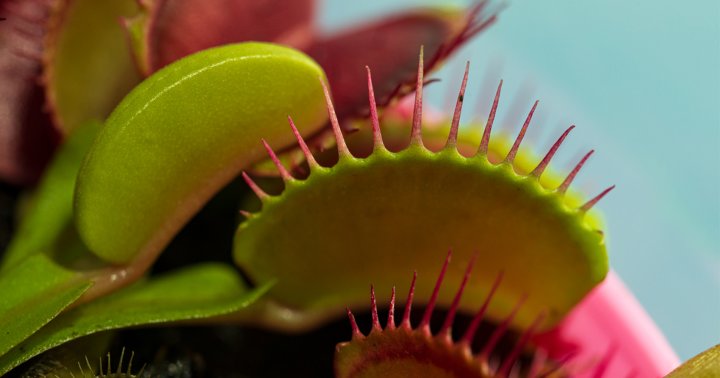12 Pretty Plants That Can Stay Alive For 2+ Weeks Without Water
Experts say these will stay lush, even when water is lacking.

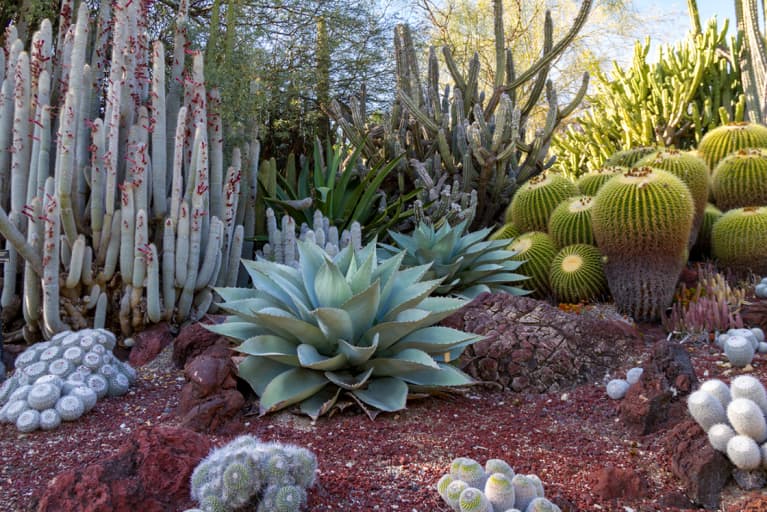
Our editors have independently chosen the products listed on this page. If you purchase something mentioned in this article, we may earn a small commission.
October 14, 2022 — 10:06 AM
Live in a dry climate or just trying to cut down on your water consumption at home? Drought-tolerant plants can bring maximum color and life to your garden with minimum effort and resources.
When choosing the best ones for your yard, Karen Hugg, gardener and author of Leaf Your Troubles Behind, recommends looking to native plants first, since you know they'll be well-adapted to your climate. Brandy Hall, founder of Shades of Green Permaculture, adds that you can also look for plants that have deep root systems, succulent leaves, or other adaptations that allow them to thrive in dry and hot areas.
Here, Hugg and Hall share their top 12 picks for drought-tolerant plants that can go a long time without water—plus, each one's care needs and ideal environments.
1. California Poppy (Eschscholzia californica)
California’s state flower thrives in full sun and well-draining soil. These perennials are very forgiving about soil quality and should do fine in sandy, rocky locations. As far as watering goes, they can go 2-4 weeks without rainfall. They have a relatively short flowering window—typically a few weeks in the late spring—but their blooms will add a vibrant pop of color to your yard. (Hugg loves the way they look next to purple varieties like lavender.) Deadheading them regularly will help extend their flowering period.
Hardiness zones: Zones 8 to 10 (Southern states, California, Western Oregon and Washington)
Water needs: Water every 2-4 weeks
Blooms in: Late spring
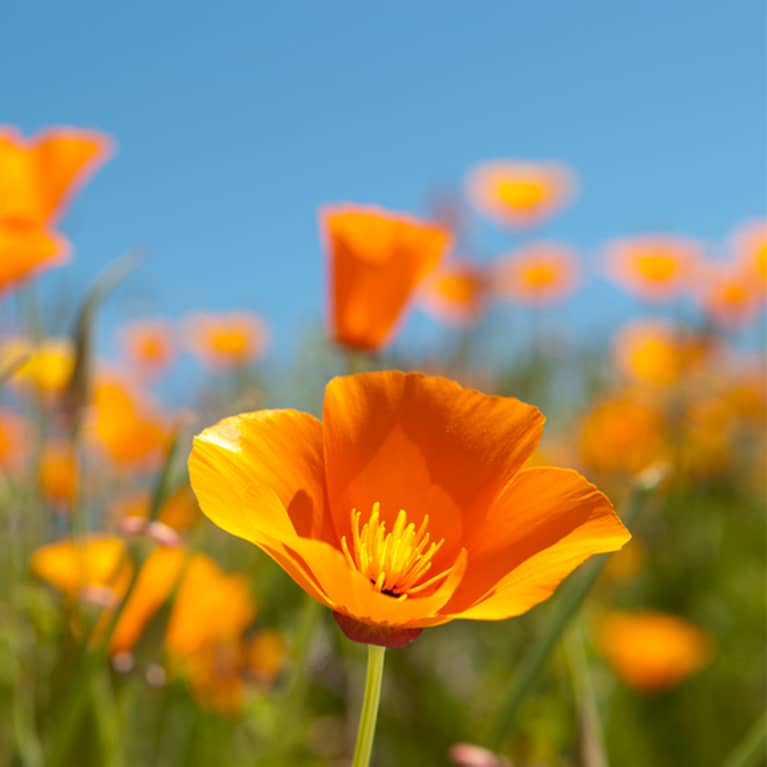
rubiophoto / iStock
2. Red Hot Poker (Kniphofia uvaria)
Also known as the torch lily, this commanding plant will add height and texture to your garden arrangements. The Red Hot Poker is suitably named for its dramatic red-orange blooms and it delivers the drama with relatively little water (though it's not as drought resistant as other options on the list). The easiest way to keep this perennial plant happy is by giving it enough space. Be sure to place it 1-2 feet away from your other blooms.
Hardiness zones: Zones 6 to 9 (Most states except the midwest, upstate New York, Maine, and Vermont)
Water needs: Water every 1-2 weeks
Blooms in: Late spring and summer

aimintang / iStock
3. Black-eyed Susans (Rudbeckia hirta)
Native to the Eastern and Central U.S., this wildflower—a cousin of the daisy—brings on the cheer. You may see Black-eyed Susans growing in inhospitable conditions like along roadsides; proving how hardy they are once they're in the ground. They can withstand periods of cold and high heat, and they've adapted to grow in partial shade as well as full sun. Hall notes that thanks to their deep, wide root systems, they're good at soaking up water too.
Hardiness zones: Zones 3 to 10 (Most states)
Water needs: Water every 1-2 weeks
Blooms in: Late summer and fall

dolah / iStock
4. Little bluestem (Schizachyrium scoparium)
This wispy prairie grass adds a soft touch to any garden and can produce some flowering stems in late summer. Once it's established, the grass is quick to grow and doesn't need much in order to spread (becoming invasive in some conditions). Little bluestem does well in all types of soils, and can even thrive in clay. It prefers to stay on the dry side, making it a great drought-tolerant option.
Hardiness zones: Zones 3 to 9 (Most states)
Water needs: Water every 2-3 weeks
Blooms in: Late summer
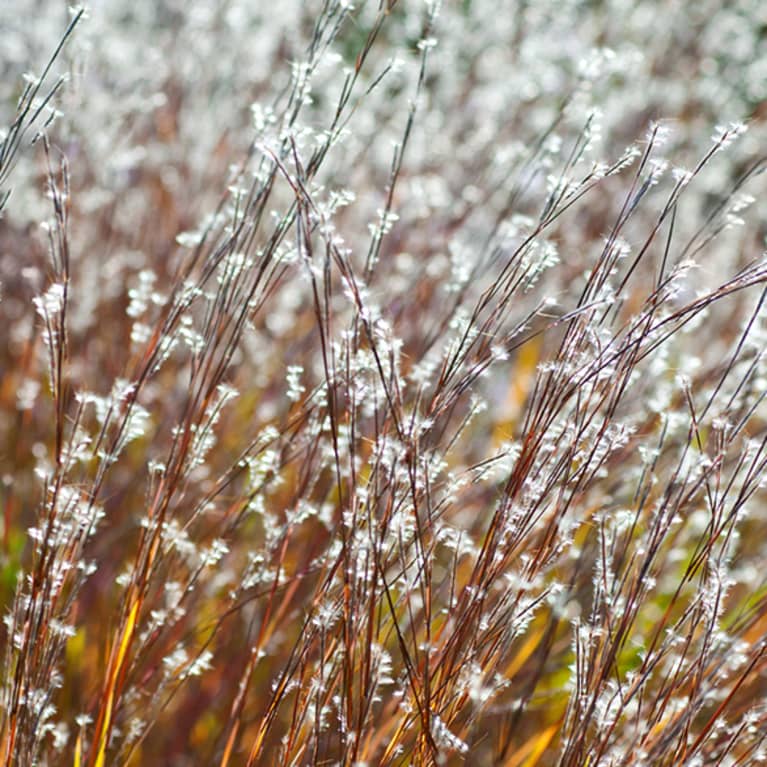
AlpamayoPhoto / iStock
5. Goldenrod (Solidago canadensis)
This cheery plant is extremely low-maintenance and can withstand periods of heat, drought, and disease very well. Most of the time, it will get enough water from rainfall, but those who live in dry climates might need to give them a drink every 2-3 weeks. Bonus: hungry pollinators love its golden yellow flowers.
Hardiness zones: Zones 3 to 9 (Most states)
Water needs: Water every 2-3 weeks
Blooms in: Late summer
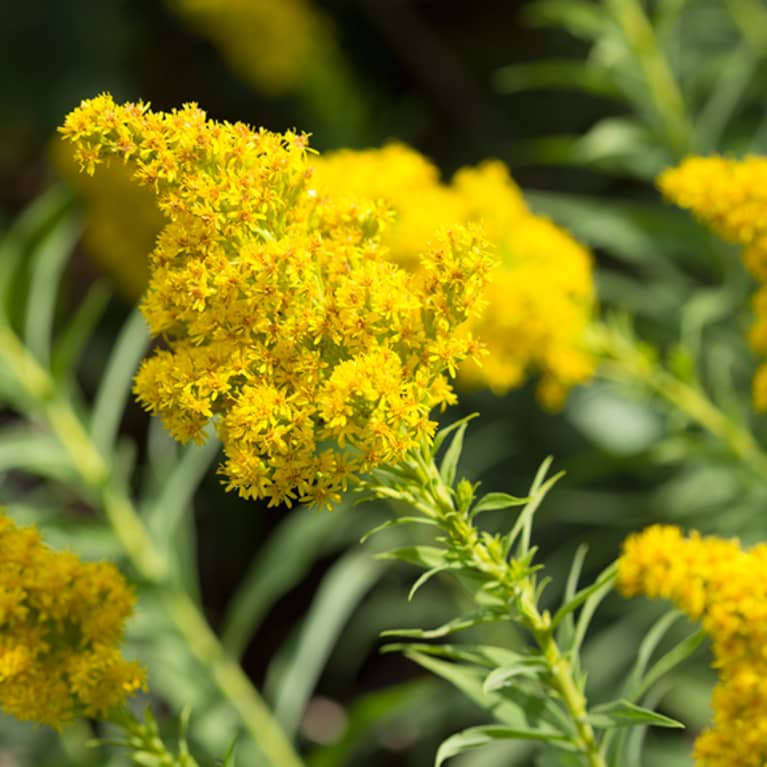
DavidOrr / iStock
6. Eastern Prickly Pear (Opuntia humifusa)
The Eastern prickly pear, or devil's-tongue, is a classic cactus that puts out flowers and edible fruit in the right conditions. Like most types of succulents, the prickly pear stores water in its leaves as a reserve during times of drought, making it a great pick for dry areas. Give it plenty of sunlight and well-draining soil, and you'll be able to get away with going up to a month or more without watering.
Hardiness zones: Zones 4 to 9 (Most states except the upper midwest)
Water needs: Water every 3-4 weeks
Blooms in: Early summer
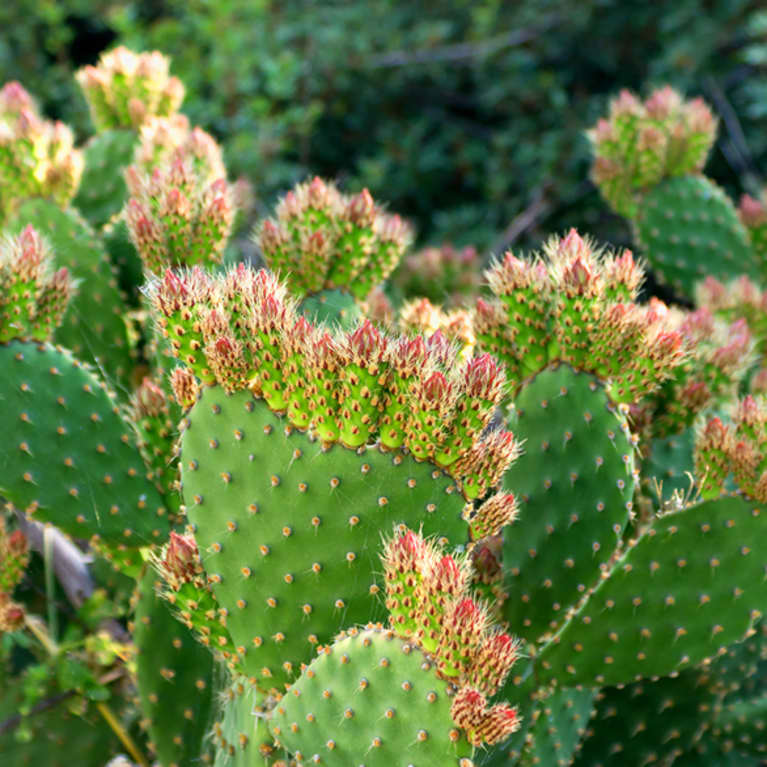
Liountmila Korelidou / iStock
7. Sunflowers (Helianthus)
Lively sunflowers can make beautiful additions to your cutting garden or container arrangement, and Hall loves them as a drought-tolerant option. Give them well-draining soil, place them in a spot that gets plenty of light, and water them every 1-2 weeks to watch them grow tall and strong.
Hardiness zones: Zones 4 to 9 (Most states except the upper midwest)
Water needs: Water every 1-2 weeks
Blooms in: Summer

Clearphoto / iStock
8. Autumn Joy (Sedum telephium)
Hugg refers to the Autumn Joy (a type of sedum/ stonecrop) as one of the "greatest hits" of drought-tolerant plants. And for good reason: Sedums are perennial plants that come in vibrant colors and are super easy to care for. Since they're technically succulents, they store water in their fleshy stems and leaves and can go weeks without watering. Come autumn, they stay true to their name and produce joyful red-pink flower clusters.
Hardiness zones: Zones 3 to 9 (Most states)
Water needs: Water every 2 to 4 weeks
Blooms in: Fall
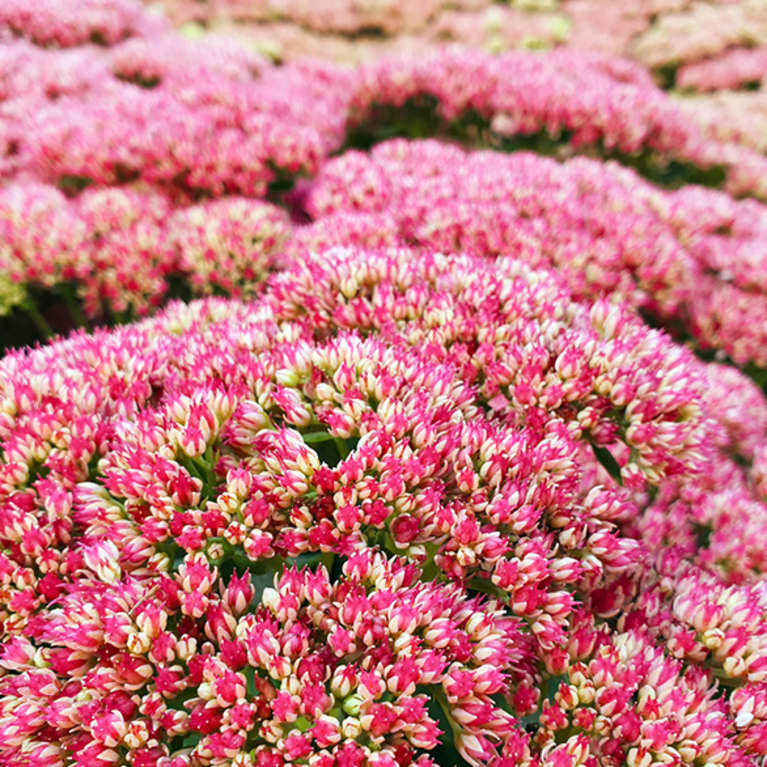
Anastasiia Burlakova / iStock
9. Agave (Agave)
Those who live in really hot, dry climates will be able to keep agave plants at home. In the right conditions, agave can grow up to 30 feet tall and produce striking flowers once in a blue moon. This type of succulent really hates the cold and requires full sun and gritty soil—but once it's in a good spot, it can stay alive with practically no water.
Hardiness zones: Zones 8 or 9 (Southern states, California)
Water needs: Water every 2 to 4 weeks
Blooms in: Every 5-10 years
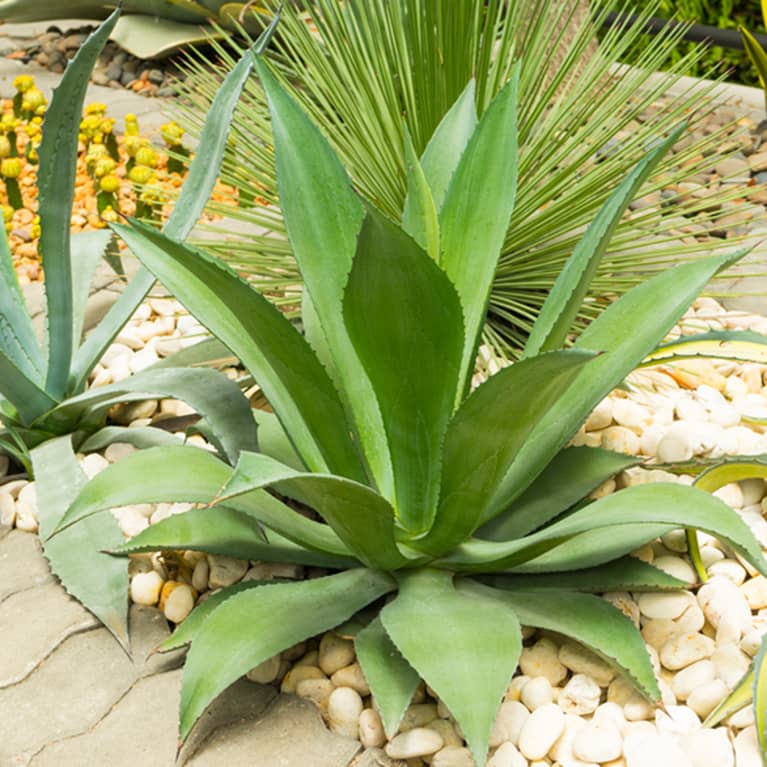
ben-bryant / iStock
10. Blue Star Juniper (Juniperus squamata)
Hugg notes that the fragrant Blue Juniper is a surprisingly drought-resistant evergreen shrub that can also withstand periods of extreme heat. (Its blue waxy coating serves as protection from the hot sun!) While they need more frequent watering during their first year in the ground, these shrubs can go weeks without watering once established.
Hardiness zones: Zones 4 to 8 (Most states except the upper midwest)
Water needs: Every 2-3 weeks once mature
Blooms in: N/A
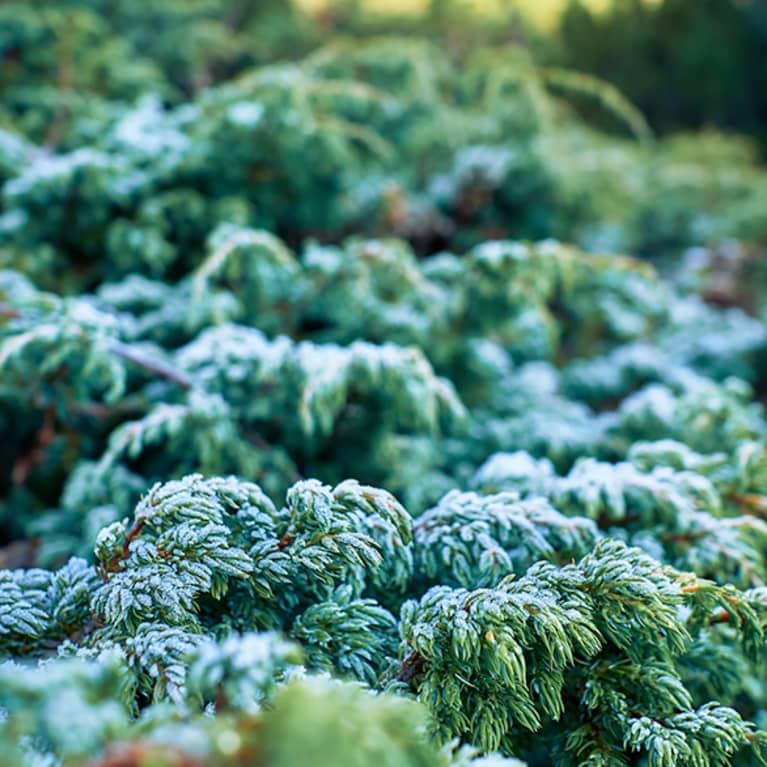
ed chechine / iStock
11. Yarrow (Achillea millefolium)
Yarrow has long been grown for medicinal use, but the drought-tolerant perennial also just adds a pretty touch to any garden. The adaptable plant can thrive just about anywhere where it gets full sun. (It won't produce as many flowers in shady conditions.) Its delicate-looking flowers will stick around all the way from spring to fall, and they'll grow extra lush with regular pruning.
Hardiness zones: Zones 3 to 9 (Most states)
Water needs: Water every 2 to 4 weeks
Blooms in: Spring to fall
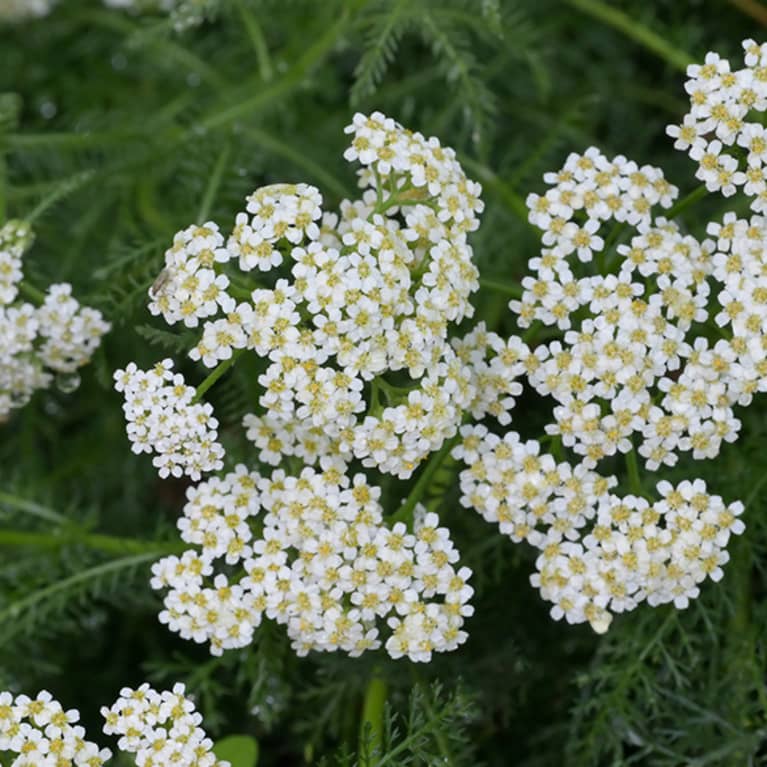
mauribo / iStock
12. English Lavender (Lavandula angustifolia)
Lavender plants will give your garden a gorgeous aroma and pop of color for relatively little work. They need plenty of light but can go a few weeks in between watering. Just prune them annually and be sure to give them enough room to grow.
Hardiness zones: Zones 5 to 10 (Most states excerpt the upper northeast and midwest)
Water needs: Water every 2 to 3 weeks
Blooms in: Late spring
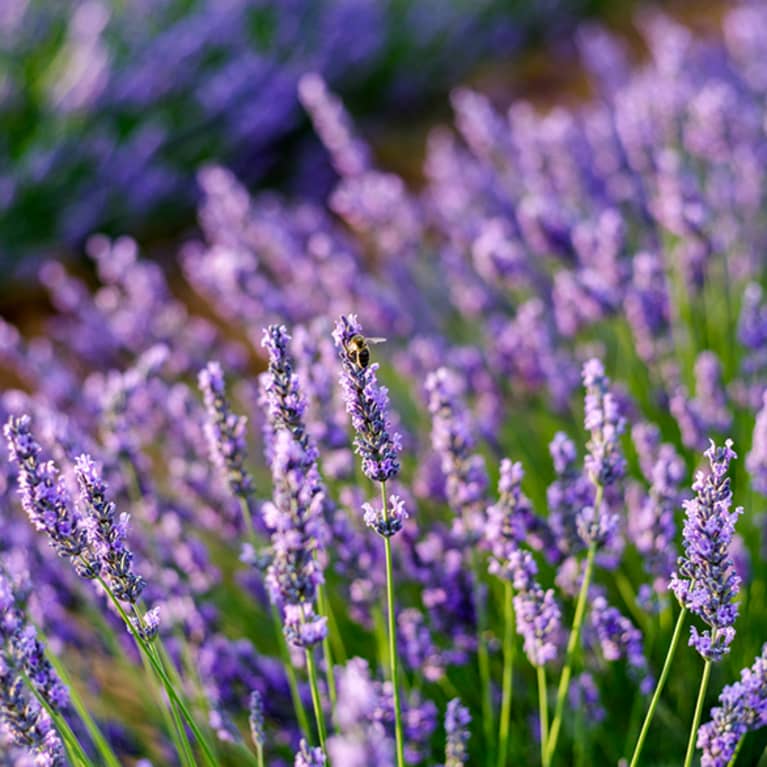
Jose Gonzalez Buenaposada / iStock
How to design your drought-tolerant garden.
1. Plant for your unique site.
Hall, who has over 15 years of experience in landscaping and permaculture design, notes that choosing plants that are equipped for your location is key. "A lot of it comes down to 'right plant, right place,'" she tells mbg. This means that you can't go wrong choosing flowers that are native or adapted to your soil, light, and of course, water conditions. Native plants will also usually be more beneficial for local wildlife.
At the very least, a plant should be able to thrive in your USDA Hardiness Zone and not be considered invasive in your area.
2. Maximize your water flow.
If you live in a dry area, consider designing your yard as a rain garden to maximize any precipitation you get throughout the year. Collecting rainwater and grouping plants with similar water needs together can also help you maximize the water you do have.
Container gardens tend to dry out faster and require more water, so aim to get most of your plants into the ground if you can.
Ask yourself: Do you really need that bright green, perfectly manicured lawn? Grass lawns tend to require tons of water to maintain (especially if you live in a dry climate), and more drought-tolerant alternatives like clover lawns are just as lovely.
Drought-tolerant plants will make your garden more resilient, easier to care for, and more sustainable. The key is to choose ones that are native to your area, or at least suitable to your USDA Hardiness Zone. Mix and match the bright blooms, fragrant evergreens, and funky succulents on this gardener-approved list for a backyard oasis that stays lush even when water is lacking.
Want to learn how feng shui can help you create a high-vibe home and set powerful intentions to manifest your dreams? This is feng shui the modern way - no superstitions, all good vibes. Click here to register for a free session with Dana that will give you 3 tips to transform your home today!
Reset Your Gut
Sign up for our FREE doctor-approved gut health guide featuring shopping lists, recipes, and tips
You are now subscribed
Be on the lookout for a welcome email in your inbox!
https://www.mindbodygreen.com/articles/drought-tolerant-plants

 Hollif
Hollif 








